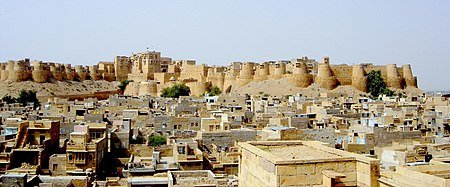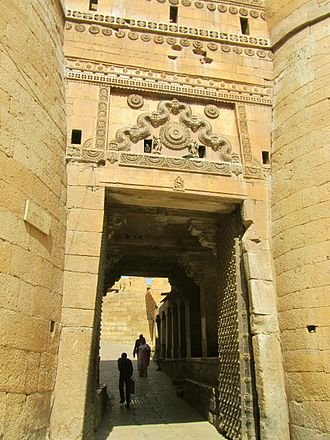Jaisalmer Fort
Jaisalmer Fort is situated in the city of Jaisalmer, in the Indian state of Rajasthan. It is one of the very few “living forts” in the world (such as Carcassonne, France), as nearly one fourth of the old city’s population still resides within the fort. For the better part of its 860-year history, the fort was the city of Jaisalmer. The first settlements outside the fort walls, to accommodate the growing population of Jaisalmer, are said to have come up in the 17th century.
Jaisalmer Fort is the second oldest fort in Rajasthan, built in 1156 AD by the Rawal (ruler) Jaisal from whom it derives its name, and stood at the crossroads of important trade routes (including the ancient Silk road).
Jaisalmer Fort
Swarna Durg, Jaisalmer Quilla or Sonar Quila
Jaisalmer, Rajasthan, India

The fort’s massive yellow sandstone walls are a tawny lion colour during the day, fading to honey-gold as the sun sets, thereby camouflaging the fort in the yellow desert. For this reason it is also known as the Swarn Durg, Sonar Quila or Golden Fort. The name Sonar Quila (Bengali for Golden Fortress) was popularized by tourists after famous Bengali film of the same name, that was shot in this fort by eminent filmmaker Satyajit Ray. The fort stands amidst the sandy expanse of the great Thar Desert on Trikuta Hill, hence also known as Trikutgarh. It is today located along the southern edge of the city that bears its name; its dominant hilltop location making the sprawling towers of its fortifications visible for many miles around.
In 2013, at the 37th session of the World Heritage Committee held in Phnom Penh, Cambodia, Jaisalmer Fort, along with five other forts of Rajasthan, was declared a UNESCO World Heritage Site under the group Hill Forts of Rajasthan.

Jaisalmer fort global map
History
Legend has it that the fort was built by Rawal Jaisal, a Bhati Rajput, in 1156 CE. The story says that it superseded an earlier construction at Lodhruva, with which Jaisal was unsatisfied and thus, a new capital was established when Jaisal founded the city of Jaisalmer.
Around 1299 CE, Rawal Jait Singh I faced a long siege by Alauddin Khalji of Delhi Sultanate, who is said to have been provoked by a Bhati raid on his treasure caravan. By the end of the siege, facing certain defeat, the Bhati Rajput women committed ‘Jauhar’, and the male warriors under the command of Mularaja met their fatal end in battle with the Sultan’s forces. For a few years after the successful siege, the fort remained under the sway of Delhi Sultanate, before being eventually reoccupied by some surviving Bhatis.
During Rawal Lunakaran’s reign, around 1530–1551 CE, the fort was attacked by an Afghan chief Amir Ali. When it seemed to the Rawal that he was fighting a losing battle, he slaughtered his womenfolk as there was insufficient time to arrange a jauhar. Tragically, reinforcements arrived immediately after the deed was done and the army of Jaisalmer became victorious in its defence of the fort.
In 1541 CE, Rawal Lunakaran also fought Mughal emperor Humayun when the latter attacked the fort on his way to Ajmer. He also offered his daughter in marriage to Akbar. Mughals controlled the fort until 1762.
The fort remained under the control of Mughals until 1762, when Maharawal Mulraj took control of the fort.
The treaty between the East India Company and Mulraj on 12 December 1818 allowed the Mulraj to retain control of the fort and provided for protection from invasion. After the death of Mulraj in 1820, his grandson Gaj Singh inherited control of the fort.
With the advent of British rule, the emergence of maritime trade and the growth of the port of Bombay led to the gradual economic decline of Jaisalmer. After independence and the Partition of India, the ancient trade route was totally closed, thus permanently removing the city from its former role of importance in international commerce. Nonetheless, the continued strategic importance of Jaisalmer was demonstrated during the 1965 and 1971 wars between India and Pakistan.

“A view of the fortress above the city, in the evening”

“Jaisalmer Fort Inner View”
The town comprises the palace grounds, merchants‘ havelis (villas), residential complexes, military quarters, and temples, each competing as a symbol of the medieval prosperity of Jaisalmer.
The fort, completed in the 12th century and known locally as the sonar quila (golden fort), now forms the heart of the city of Jaisalmer. Its buildings are a subtle blend of Rajput and Islamic architectural styles, the most elaborate and elegant of these being the Patwon ki Haveli, a group of five residences commissioned by Guman Chand Patwa, an affluent local merchant. Every inch of the houses were intricately carved in stone, reportedly over a span of 50 years, a fitting tribute to the local craftsmanship. Sadly, modern times are taking their toll on this once glorious settlement. This large desert fort continues to stand tall, however; glowing in the first light of dawn, only just retaining its dignity and sense of indestructibility. (Bidisha Sinha)


Architecture
The fort is 1,500 ft (460 m) long and 750 ft (230 m) wide and is built on a hill that raises above a height of 250 ft (76 m) above the surrounding countryside. The base of the fort has a 15 ft (4.6 m) tall wall forming the fort’s outermost ring, within its triple ringed defence architecture. The fort’s upper bastions or towers form a defensive inner-wall perimeter that is about 2.5 mi (4.0 km) long. The fort now incorporates 99 bastions, of which 92 were built or substantially rebuilt between the period of 1633–47. The fort also has four fortified entrances or gates from the townside, one of which was once guarded by cannon. Other points of interest within the fort’s walls and grounds include:
- Four massive gateways through which visitors to the fort must pass, situated along with the main approach to the citadel.
- The Raj Mahal Palace, former residence of the Maharawal of Jaisalmer.
- Jain Temples: Inside Jaisalmer Fort, there are 7 Jain temples built by yellow sandstone during 12–16th century. Askaran Chopra of merta built a huge temple dedicated to Sambhavanatha. The temple has more than 600 idols with many old scriptures. Chopra Panchaji built Ashtapadh temple inside the fort.
- The Laxminath temple of Jaisalmer, dedicated to the worship of the gods Lakshmi and Vishnu.

Suarj Pol, one of the entry gates to the Jaisalmer Fort
- Numerous Merchant Havelis. These are large houses often built by wealthy merchants in Rajasthani towns and cities in North India, with ornate sandstone carvings. Some havelis are many hundreds of years old. In Jaisalmer there are many elaborate havelis carved from yellow sandstone. Some of these have many floors and countless rooms, with decorated windows, archways, doors and balconies. Some havelis are today museums but most in Jaisalmer are still lived in by the families that built them. Among these is the Vyas haveli which was built in the 15th century, which is still occupied by the descendants of the original builders. Another example is the Shree Nath Palace which was once inhabited by the prime minister of Jaisalmer. Some of the doors and ceilings are notable examples of old carved wood from many hundreds of years ago.
- Nathmal Haweli is an iconic monument of Jaisalmer fort. It is built in yellow sand stone that shines like gold under Sun. The haweli is named after Nathmal, the then Prime minister at the court of Jaisalmer. It was built by two brothers Lulu and Hathi, simultaneously, from different segments. For this reason, the building has no symmetry, yet it is an excellent piece of art, and ornate architecture. These architects left their signature at the plinth of the building as a carving of a Rajputana warrior on elephant. The building is characteristically identified with two elephants on either side. The building is a mix of Islamic and Rajputana style of architecture.
The fort has an ingenious drainage system called the ghut nali which allows for the easy drainage of rainwater away from the fort in all four directions of the fort. Over the years, haphazard construction activities and building of new roads has greatly reduced its effectiveness.









